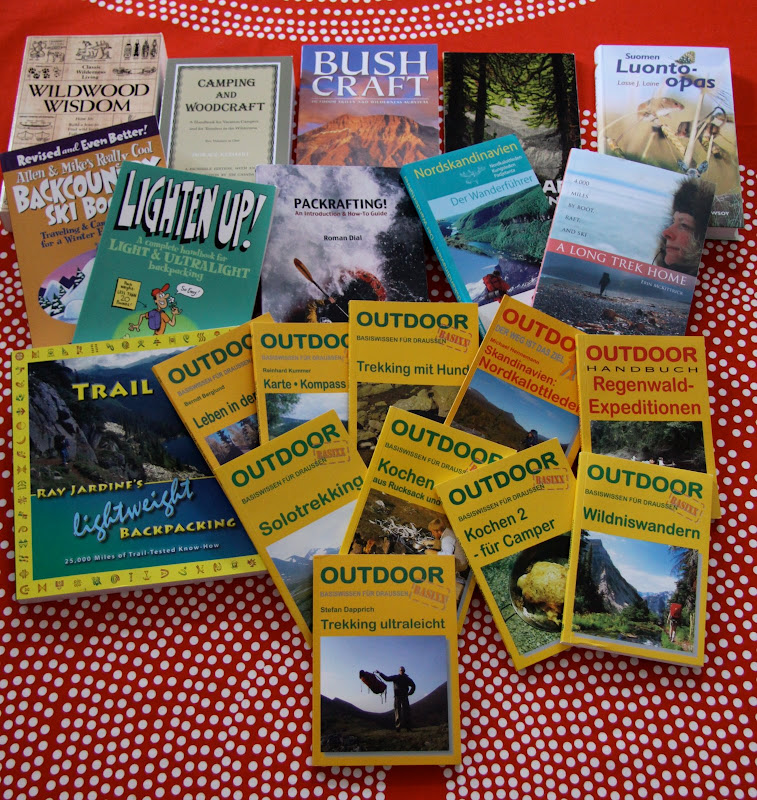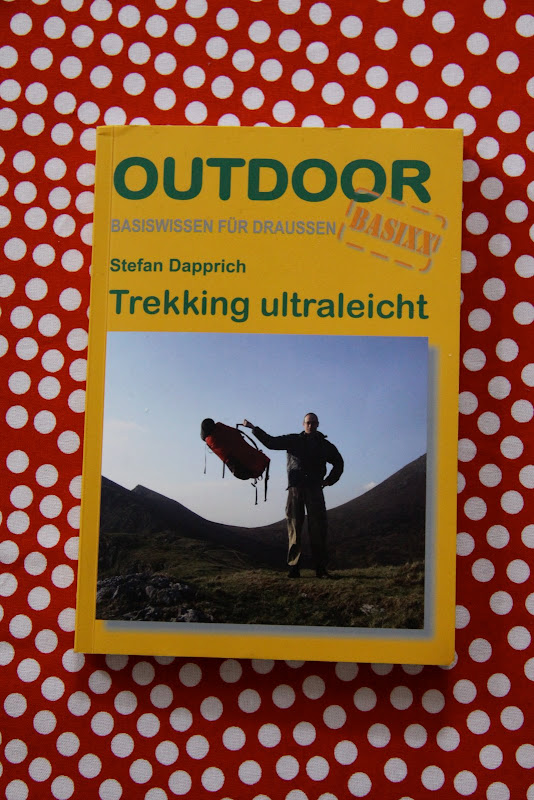I do read a lot, and not only online. I really enjoy reading a book over breakfast or the afternoon coffee, and also when I go hiking it can be great to have a book with you for those long evenings at the campfire in winter. In this series I will introduce you to some books which I have read and found useful, so if you're a book rat like me, read on!

Part of my collection of backpacking, bushcraft and outdoor related books.
The first book I'd like to introduce you to is Trekking Ultraleicht from Stefan Dapprich. I won this book in a raffle, and its in German. Its weight of 129 g and the small size mean that it fits easily into my backpack for a trip, in case I want to brush up on something or just read it again.
from Stefan Dapprich. I won this book in a raffle, and its in German. Its weight of 129 g and the small size mean that it fits easily into my backpack for a trip, in case I want to brush up on something or just read it again.

Trekking Ultraleicht by Stefan Dapprich
The book is clearly aimed at people who are new to ultralight backpacking, and it is a good introduction to the philosophy of UL backpacking, with tips on gear and useful skills to know. The gear recommendations in the book are a bit outdated and odd in my opinion, but that is for a print medium negligible I think - especially since the book is connected to the German trekking-ultraleicht.de forum where readers can discuss their questions and get more up-to-date suggestions on gear.
Trekking Ultraleicht goes over the big three, kitchen, water, food, clothing and various other items, and has MYOG plans in it as well. A definite highlight of the book is the food section, and the author's recipe for pemmican is absolutely delicious, as I was able to taste for myself on the last tour. I will attempt to make some of this myself for future trips, and shall share my recipe in a how-to post.
goes over the big three, kitchen, water, food, clothing and various other items, and has MYOG plans in it as well. A definite highlight of the book is the food section, and the author's recipe for pemmican is absolutely delicious, as I was able to taste for myself on the last tour. I will attempt to make some of this myself for future trips, and shall share my recipe in a how-to post.
The author writes in an easy to understand way, and one clearly sees that he know what he writes about. He has been UL on tour in various different parts of the world, from the Australian Outback to Greenland, and thus his recommendations are based on his own experience and not only (internet) research. I really like that he recommends a lot of basic household items, for example Ziploc bags and small containers for the storage of food and other items which need to stay dry - this not only saves money, but is often overlooked in favour of more expensive drysacks and whatnot.
To conclude, the 140 pages of content are a excellent first step for anyone interested in ultralight backpacking, with useful tips for how to make the change from heavy to light, plenty of photos, pack lists for summer and autumn/ spring trips and a good overview of UL gear choices - maybe slightly outdated by now, but on the other hand some of them are already classics. I believe that spending the 9,90€ for the book helps to save money in the long term, because you will know what to look for and don't need to spend money on a variety of other gear that you might not need.
Disclosure: I have an Amazon Affiliate account, and if you click on the link and buy the book I even might earn a few euros - for more books!
Part of my collection of backpacking, bushcraft and outdoor related books.
The first book I'd like to introduce you to is Trekking Ultraleicht
Trekking Ultraleicht by Stefan Dapprich
The book is clearly aimed at people who are new to ultralight backpacking, and it is a good introduction to the philosophy of UL backpacking, with tips on gear and useful skills to know. The gear recommendations in the book are a bit outdated and odd in my opinion, but that is for a print medium negligible I think - especially since the book is connected to the German trekking-ultraleicht.de forum where readers can discuss their questions and get more up-to-date suggestions on gear.
Trekking Ultraleicht
The author writes in an easy to understand way, and one clearly sees that he know what he writes about. He has been UL on tour in various different parts of the world, from the Australian Outback to Greenland, and thus his recommendations are based on his own experience and not only (internet) research. I really like that he recommends a lot of basic household items, for example Ziploc bags and small containers for the storage of food and other items which need to stay dry - this not only saves money, but is often overlooked in favour of more expensive drysacks and whatnot.
To conclude, the 140 pages of content are a excellent first step for anyone interested in ultralight backpacking, with useful tips for how to make the change from heavy to light, plenty of photos, pack lists for summer and autumn/ spring trips and a good overview of UL gear choices - maybe slightly outdated by now, but on the other hand some of them are already classics. I believe that spending the 9,90€ for the book helps to save money in the long term, because you will know what to look for and don't need to spend money on a variety of other gear that you might not need.
Disclosure: I have an Amazon Affiliate account, and if you click on the link and buy the book I even might earn a few euros - for more books!